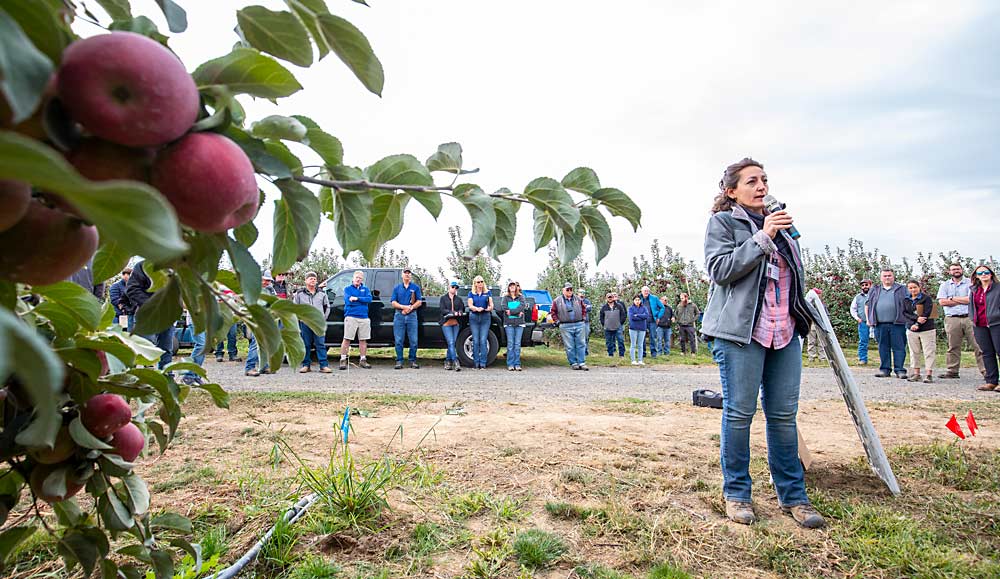
Across Washington, WA 38 orchards are nearing harvest, and growers and researchers have dialed in their approach to harvest timing.
It comes down to both starch and background color, experts said at a preharvest field day organized by Washington State University on Sept. 17 in the Wenatchee and Quincy areas. And they said it again at another field day in Prosser on Sept. 22.
“Flavor is a key component of the apple’s success,” said Jill Burberry of Proprietary Variety Management, the company licensed by WSU to manage Cosmic Crisp commercialization. In addition to targeting a 2.0 on the starch scale developed by the Washington Tree Fruit Research Commission, the fruit should have a breaking background color that’s no longer hard green.
She also shared that for the 2021 season PVM hired a quality control manager who would be visiting the more than 40 warehouses now handling Cosmic Crisp to ensure the fruit on the lines meets the brand’s quality standards.
The field days also covered a variety of research updates from WSU scientists looking at everything from crop load management to heat stress.
Physiologist Sara Serra introduced a research project designed to see if plant growth regulators can help to boost fruit set — WA 38 tends to set only one fruit per cluster.
“This variety has abundant bloom but drops a lot of fruitlets,” she said. So, she and Tory Schmidt of the research commission designed a trial to see if ReTain or Harvista could increase fruit set by extending the flower’s viability and pollination window. Both were applied at label rates at 50 percent king bloom and seven days later.
Monument Hill Orchards in Quincy hosts the trial, and while overall the crop load looked strong — estimated at 65 to 70 bins per acre in the fourth-leaf block, according to orchard manager Jorge Acevedo — Serra said they had not yet seen significant differences from the PGR applications, but they will have more data after harvest.
Serra also shared an update on another trial to see if deploying reflective mulch in May will have an effect on fruit set. The idea is that doing so might boost the tree’s photosynthesis levels during the time it’s usually dropping fruitlets, potentially helping it hold on to more.
Acevedo introduced growers to the management of the fourth-leaf orchard, planted on Nic.29 rootstocks. He said that aside from the trial, all the crop load management is done through winter pruning with the click pruning approach WSU’s Stefano Musacchi promotes for WA 38.
He’s happy with the vigor in the block and wouldn’t change much about the approach to establishing the orchard, Acevedo told the gathered audience. It was shovel-planted after the trellis and irrigation was up, on former potato ground. They used fertigation three times a week in the first leaf, then slowed it in the second and used some Apogee in the lower part of the trees in the third leaf to dial in the vigor.
While the orchard did have some fruit develop green spot in the past, he’s seen few signs of it this year. “We didn’t do anything (different),” he said. “As the trees get older, the fruit gets better.”
Equipment demonstrations highlighted the Prosser field day. Attendees watched a Cyclone vacuum harvest-assist prototype, two defoliating machines and a hands-free stem clipper.
The makers of the Bandit Cyclone have begun commercial trials with the final prototype of the vacuum-powered machine, which pickers use by feeding apples into a suction tube that leads to a rotating dispenser that fills a bin carried by the Bandit platform. It’s made by Automated Ag Systems of Moses Lake, Washington, and DBR Conveyor Concepts of Conklin, Michigan.
The companies have been working on the machine for many years and have recently added a Maf bin-filler head. With the Cyclone, workers fill a bin every nine minutes, compared to 16 minutes without the vacuum machine, said JJ Dagorret, owner of Automated Ag.
He has not yet determined a retail price, he said.
Pape Machinery of Yakima deleafed two rows of WA 38s with an Olmi 509 defoliator, a new model built in Italy, while Sunnyside New Holland did the same with the German Fruit Tec REDpulse Duo. Both defoliators use a two-blower head that adjusts vertically and horizontally for either V-trellis or vertical hedges.
Both work best on two-dimensional canopies with stiff limbs.
“The more two-dimensional the block is, or the canopy is, the better it works,” said Tyler Hawkins, a sales representative for New Holland.
Meanwhile, technician Juan Mungia demonstrated the Stem Punk, a clipper that fastens to the straps of an apple bag on a picker’s chest and frees the worker’s hands. Pickers use the Stem Punk by inserting a stem into the clipper and depressing a spring actuator with their forearms.
WSU recommends clipping the stems of WA 38 to avoid punctures.
Leighton Rice, of Rice Fruit Co. in Pennsylvania, developed the Stem Punk. He sent a bunch to Karen Lewis, a WSU horticulture extension specialist, to give out at the field day, as long as growers promised to send feedback.
A reasonable request, Lewis said. “That’s the way the world is going to have to work for us.”
—by Kate Prengaman and Ross Courtney

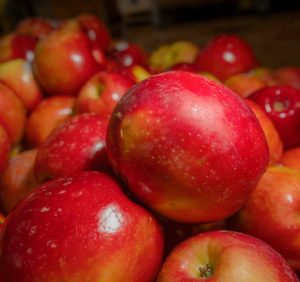
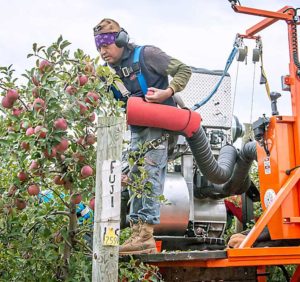
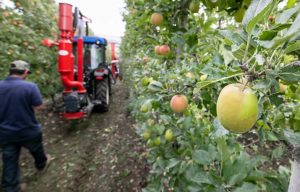
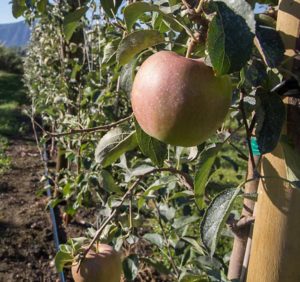





Leave A Comment